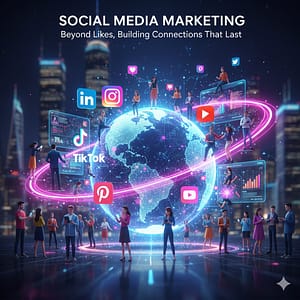Decoding Desire: The Unseen Psychology Behind Successful Branding
Why do you pay a premium for a MacBook when a different laptop has similar specs? Why do you choose Nike over other athletic brands? Why does the sight of the Coca-Cola logo evoke a feeling of nostalgia and refreshment?
The answer isn’t just about product quality or clever advertising. It’s about psychology.
Successful branding goes far beyond a catchy name and a pretty logo. The most iconic brands in the world are masters of consumer psychology. They understand the subconscious triggers, cognitive biases, and emotional drivers that influence our decisions. They don’t just sell a product; they sell a feeling, an identity, and a promise.
Understanding the psychology of branding is your key to moving from a forgettable business to a beloved brand. Let’s dive into the seven core psychological principles that make a brand successful.
1. The First Glance: Color, Shape, and the Psychology of Design
Before a customer reads a single word about your company, they see your design. Our brains are wired to process visual information almost instantly, and this first impression is incredibly powerful.
- Color Psychology: Colors evoke specific emotions and associations. For example, blue often conveys trust and security (think Facebook, PayPal, and IBM), while red signifies passion, excitement, and urgency (think Coca-Cola, Netflix, and Target). Green is associated with nature, health, and wealth. Choosing the right color palette is crucial for setting the desired emotional tone.
- Shape & Font Psychology: The shapes in your logo and the fonts you use also send subconscious messages. Rounded shapes and fonts feel friendly and approachable, while sharp, angular designs convey strength and efficiency. A traditional serif font can suggest authority and heritage, whereas a modern sans-serif font feels clean and innovative.
2. Finding Your Soul: How Brand Archetypes Create Connection
Humans have used stories and archetypes to make sense of the world for millennia. Swiss psychiatrist Carl Jung theorized that we all have a collective unconscious that responds to universal character patterns, or “archetypes.”
Successful brands tap into this by embodying a specific archetype to create a relatable brand personality.
- The Hero: Resolute, courageous, and inspiring. Example: Nike (“Just Do It”).
- The Sage: A source of wisdom and information. Example: Google.
- The Rebel: Challenges the status quo and forges a new path. Example: Apple (in its early days with the “1984” ad).
- The Caregiver: Nurturing, compassionate, and protective. Example: Johnson & Johnson.
By aligning with an archetype, your brand becomes more than a faceless corporation; it becomes a character in your customer’s story.
3. The Power of Narrative: Why Brand Storytelling Works
Our brains are wired for stories. A compelling narrative releases oxytocin, the “bonding hormone,” which helps create trust and empathy. A brand that tells a great story can forge a deep emotional connection with its audience.
Your brand story isn’t just a marketing gimmick; it’s the “why” behind what you do. It encompasses your mission, your values, and your origin. TOMS Shoes built an empire on its “One for One” story—buy a pair of shoes, and they give a pair to a child in need. This narrative transformed a simple purchase into a meaningful act of charity.
4. The Herd Mentality: Using Social Proof to Build Trust
As social creatures, we are heavily influenced by the actions and opinions of others. This principle, known as social proof, is a powerful tool in branding. When we see that others trust a brand, we are more likely to trust it ourselves.
Brands leverage social proof through:
- Customer testimonials and reviews
- Influencer endorsements
- User-generated content on social media
- Displaying client logos and case studies
Showcasing that real people love and use your product is one of the fastest ways to build credibility and overcome purchase hesitation.
5. Less is More: The Psychology of Simplicity and Choice
Have you ever felt overwhelmed by a restaurant menu with too many options? This is known as the Paradox of Choice. Psychologically, having too many choices can lead to anxiety and decision paralysis.
The most successful brands understand this. Apple is a master of simplicity. They offer a curated selection of products, making the decision-making process easy for consumers. Their messaging is clear, their website is clean, and their user interface is intuitive.
A brand that simplifies choices and communicates its value proposition clearly reduces cognitive load for the customer, creating a more pleasant and effective brand experience.
6. The Familiarity Principle: Repetition Breeds Recognition
The Mere-Exposure Effect is a psychological phenomenon where people develop a preference for things simply because they are familiar with them. The more we see something, the more we tend to like and trust it.
This is why brand consistency is non-negotiable. Your logo, color scheme, messaging, and tone of voice must be consistent across all touchpoints—your website, social media channels, packaging, and customer service. Every interaction is an opportunity to reinforce your brand identity. Consistent repetition is what makes a logo like the McDonald’s golden arches instantly recognizable and trusted worldwide.
7. Creating a Tribe: The Psychology of Belonging
At our core, humans have a deep-seated need to belong to a group. Elite brands capitalize on this by cultivating a sense of community and shared identity around their products.
Harley-Davidson doesn’t just sell motorcycles; it sells a rebellious spirit and membership to a brotherhood. Peloton doesn’t just sell exercise equipment; it sells a connection to a global community of fitness enthusiasts.
When you build a brand that stands for something, you attract people who share those values. You transform customers into advocates and create a loyal tribe that will stick with you for the long haul.
Conclusion: Branding is Human
Ultimately, the psychology behind successful branding is about understanding people. It’s about tapping into fundamental human needs: the need for connection, trust, simplicity, and belonging.
By weaving these psychological principles into your brand strategy, you can create more than just a business. You can build a powerful, resonant, and enduring brand that people don’t just buy from, but truly believe in.
Ready to build a brand that connects on a deeper level? Our team specializes in brand strategy rooted in consumer psychology. Contact us today for a free consultation!
What is a brand that you feel a strong psychological connection to? Share it in the comments below!













Add comment